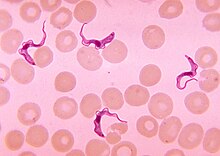
Back مثقبية Arabic مثقبيه ARZ Tripanosomlar Azerbaijani Трыпанасомы Byelorussian Трипанозома Bulgarian Tripanosoma Catalan تریپانۆسۆما CKB Trypanosoma Czech Chagas dɔro DAG Trypanosomen German
| Trypanosoma | |
|---|---|

| |
| Trypanosoma sp. among red blood cells. | |
| Scientific classification | |
| Domain: | Eukaryota |
| Phylum: | Euglenozoa |
| Class: | Kinetoplastea |
| Order: | Trypanosomatida |
| Family: | Trypanosomatidae |
| Genus: | Trypanosoma Gruby, 1843 |
| Subgenera | |
| |
| Synonyms | |
| |
Trypanosoma is a genus of kinetoplastids (class Trypanosomatidae[1]), a monophyletic[2] group of unicellular parasitic flagellate protozoa. Trypanosoma is part of the phylum Euglenozoa.[3] The name is derived from the Ancient Greek trypano- (borer) and soma (body) because of their corkscrew-like motion. Most trypanosomes are heteroxenous (requiring more than one obligatory host to complete life cycle) and most are transmitted via a vector. The majority of species are transmitted by blood-feeding invertebrates, but there are different mechanisms among the varying species. Trypanosoma equiperdum is spread between horses and other equine species by sexual contact. They are generally found in the intestine of their invertebrate host, but normally occupy the bloodstream or an intracellular environment in the vertebrate host.
Trypanosomes infect a variety of hosts and cause various diseases, including the fatal human diseases sleeping sickness, caused by Trypanosoma brucei,[4] and Chagas disease, caused by Trypanosoma cruzi.
The mitochondrial genome of the Trypanosoma, as well as of other kinetoplastids, known as the kinetoplast, is made up of a highly complex series of catenated circles and minicircles and requires a cohort of proteins for organisation during cell division.
- ^ "WHO - The parasite". WHO. Archived from the original on September 29, 2016. Retrieved 8 March 2019.
- ^ Hamilton PB, Stevens JR, Gaunt MW, Gidley J, Gibson WC (2004). "Trypanosomes are monophyletic: evidence from genes for glyceraldehyde phosphate dehydrogenase and small subunit ribosomal RNA". Int. J. Parasitol. 34 (12): 1393–404. doi:10.1016/j.ijpara.2004.08.011. PMID 15542100.
- ^ "Taxonomy of African Trypanosoma species". msu.edu. Retrieved 2019-03-28.
- ^ Büscher, Philippe; Cecchi, Giuliano; Jamonneau, Vincent; Priotto, Gerardo. "Human African trypanosomiasis". The Lancet. 390 (10110): 2397–2409. doi:10.1016/s0140-6736(17)31510-6. ISSN 0140-6736.